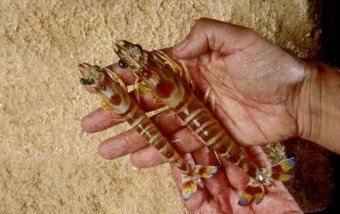Image courtesy of CSIRO.
Seafood lovers will soon be able to chuck a pedigree prawn on the barbie thanks to a project by CSIRO scientists that will give Australia the most well-bred prawns in the world.
CSIRO, through its Food into Asia program, is working to develop the better-performing prawns in collaboration with two innovative prawn farms, Rocky Point Prawn Farm and Tomei Australia, both located in southeast Queensland.
Using the DNA fingerprint technology like that used to identify criminals and fathers among humans, Dr Sigrid Lehnert of CSIRO Livestock Industries is seeking to select families, or pedigrees, of Kuruma prawns - Penaeus japonicus - which grow the fastest.
Identifying high-performance bloodlines of prawns will enable farmers to produce their own elite broodstock - much like the poultry, cattle or racehorse industries, Dr Lehnert says.
Until recently, the broodstock for Australia's burgeoning $50 million-a-year prawn farming industry were mainly caught in the wild, by trawling. Technology developed by CSIRO has now enabled domestication of this species so that farmers are developing their own improved breeding lines, according to Dr Nigel Preston of CSIRO Marine Research.
"Selection of higher-performing broodstock will lead to improvements in prawn growth rates, under farm conditions, of around 10% per generation," says Dr Preston.
"We are starting with 30 different families of prawns, half domesticated and half from the wild. We will identify each of these families genetically, and then grow the offspring all together in one large pond, under the same conditions," Dr Lehnert says.
Each family will start with two foundation parents, a male and female, and a single mating, which will yield up to 200,000 offspring.
The baby prawns - larvae - will then be released into the pond and harvested several months later. The prawns will then be weighed and measured and their parentage determined by genetic testing.
"When we first put them in the pond, the larvae are only 2mm or so long, which is a bit small to put an ear tag on, as we do with farm animals. So instead we're using DNA fingerprinting to identify their pedigree."
From the 30 families, the researchers will select those with outstanding growth and other characteristics, to serve as broodstock for the commercial prawn farming industry.
The mating habits of prawns make the use of DNA fingerprinting for identifying pedigree a necessity, says Dr Lehnert.
Female prawns mate after they moult (shed their shells) and, to ensure success, about 40 females and 25 males are placed in a tank. The male prawn deposits his sperm in the female in a parcel (spermatophore), which at the same time prevents another male from mating with her.
Since mating takes place at night, it isn't easy to be sure which male is the father, other than by using a DNA test, Dr Lehnert says. From there on, it is possible to track the offspring of that male and female down the generations.
The main outcome of the project is expected to be a reliable source of better-performing broodstock for prawn farmers, which will bring increases in production efficiency to put their industry on a similar scientific footing to other livestock industries.
"Domesticated broodstock, which you grow yourself, also enable you to control disease in a prawn farm, as you are not continually introducing wild stock which may carry unknown viruses," she says.
"A major goal is to identify the main genes associated with growth rate in P. japonicus, which is the most sought-after prawn for the export trade, especially in Japan where it is called the Kuruma prawn and fetches a very high price.
"In future we hope to identify genes associated with disease resistance and other desirable qualities."
Dr Preston says that under controlled lab conditions, a gain of 11 per cent in growth rate has been demonstrated, and this rate of gain could be expected for up to six generations - a total of 55-66 per cent.
"In trials under normal farm conditions, where there's a lot more variability in conditions, we get between 5 and 13 per cent gain per generation.
"That means there is genetic scope for an overall gain of between 25-50 per cent in prawn growth rates, within five generations under farm conditions.
"So you either get bigger prawns, or prawns that reach market size faster. Since larger prawns attract a higher market price, the value of the crop is increased with no increase in production costs. It may even be possible to develop strains that grow well on cheaper diets," he says.
Whatever the outcome, the research is expected to put Australia at the world forefront in prawn breeding, as overseas prawn farms are still almost totally reliant on stock taken from the wild, says Dr Lehnert.
"We'll have the best-bred prawns in the world, and that will keep the Australian industry internationally competitive," she says.
More information: CSIRO Marine Research CSIRO Livestock Industries











